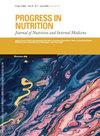The effect of seasonal variations on food consumption, dietary habits, anthropometric measurements and serum vitamin levels of University Students
4区 医学
Q4 Agricultural and Biological Sciences
引用次数: 10
Abstract
Aim: The aim of this study was to examine the effect of seasonal variations on the dietary habits, food consumption, anthropometric measurements, physical activity and some serum vitamin levels of adult females. Methods:The study was conducted during consecutive four seasons in October (autumn), January (winter), April (spring), and July (summer). After general information was obtained about the participants via questionnaire, their anthropometric measurements were taken, and individual records kept for 7-day individual food consumption and 3-day physical activity. Also, their body compositions (Body Stat 1500O) and resting metabolic rates (Ergospirometry-Cosmed K4b2) were measured. Participant serum samples were analyzed for levels of vitamins A, E, β-carotene and 25-OH Vitamin D3. Subjects: Thirty-five healthy, young adult females between the ages of 19 and 24 were invited into a prospective research study. Results: Spring was found to be the season with the highest intake of energy and nutrients compared with other seasons (p 0.05). A significant positive correlation was determined between the levels of serum β-carotene and dietary β-carotene intake in autumn (r = 0.37, p<0.05). Conclusion: It was concluded that seasonal variations have significant effect on the nutritional status, body weights and compositions, daily energy expenditures, and particular serum vitamin levels in individuals. This should be taken into consideration when developing individual nutrition plans and establishing nutrition policies in Turkey, where all four seasons are experienced conspicuously.季节变化对大学生食物消费、饮食习惯、人体测量和血清维生素水平的影响
目的:本研究的目的是研究季节变化对成年女性饮食习惯、食物消耗、人体测量、身体活动和一些血清维生素水平的影响。方法:研究采用10月(秋季)、1月(冬季)、4月(春季)、7月(夏季)四个季节连续进行。在通过问卷调查获得了参与者的一般信息后,对他们进行了人体测量,并保留了7天的个人食物消耗和3天的身体活动记录。同时,测量他们的身体成分(body Stat 1500O)和静息代谢率(ergospirometric - cosmed K4b2)。研究人员分析了参与者的血清样本中维生素A、E、β-胡萝卜素和25-OH维生素D3的水平。受试者:35名年龄在19至24岁之间的健康年轻成年女性被邀请参加一项前瞻性研究。结果:与其他季节相比,春季是能量和营养物质摄入量最高的季节(p < 0.05)。秋季血清β-胡萝卜素水平与饲粮β-胡萝卜素摄入量呈显著正相关(r = 0.37, p<0.05)。结论:季节变化对个体的营养状况、体重和组成、日能量消耗和特定血清维生素水平有显著影响。在土耳其,四季分明,在制定个人营养计划和制定营养政策时,应考虑到这一点。
本文章由计算机程序翻译,如有差异,请以英文原文为准。
求助全文
约1分钟内获得全文
求助全文
来源期刊

Progress in Nutrition
医学-营养学
CiteScore
1.40
自引率
0.00%
发文量
0
审稿时长
>12 weeks
期刊介绍:
Progress in Nutrition was founded in 1999 as an independent magazine, a multidisciplinary approach, dedicated to issues of nutrition and metabolism.
 求助内容:
求助内容: 应助结果提醒方式:
应助结果提醒方式:


